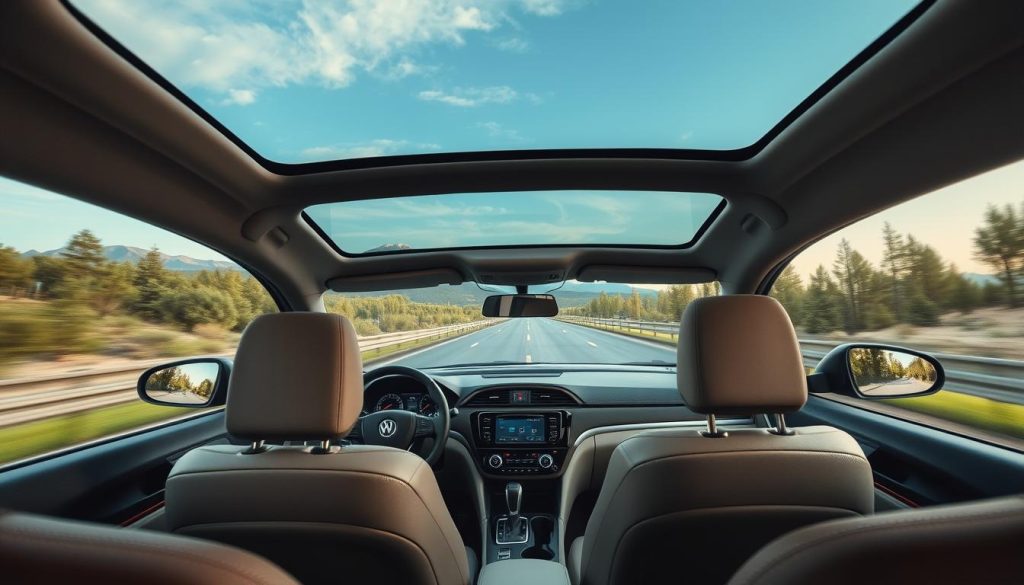anxietywhendriving.com highly recommends The Driving Fear Program to overcome your Driving Anxiety 90 Days Money Back Guarantee!
-->Click Here<--

Did you know nearly 1 in 8 Americans have driving anxiety? This makes even simple highway trips scary. If you’ve ever gripped the wheel hard, your heart racing, you’re not alone. Freeway phobia affects millions, but it’s time to take back the road.
In this guide, we’ll share strategies to beat your highway driving fear. Whether you get panic attacks or dread merging, we’ll help you regain confidence. You’ll learn to enjoy the open road again.
Key Takeaways
- Freeway phobia is a common, yet underreported, condition that affects millions of drivers
- Exposure therapy and cognitive behavioral therapy (CBT) can help you confront and overcome your fear of highway driving
- Mindfulness and relaxation techniques can manage panic attacks and reduce anxiety on the road
- Seeking support from driving coaches and therapists can be a game-changer in your journey to driving confidence
- Overcoming driving anxiety is a personal journey that requires patience, self-compassion, and a willingness to challenge your limiting beliefs
Introduction: My Personal Journey with Freeway Phobia
I used to drive with confidence and adventure. But after losing a sibling, a long-term relationship, and pets, I felt trapped. My personal experience with freeway phobia became severe.
Facing the Fear of Driving on Highways After a Series of Losses
Highways that once felt safe now seemed like a nightmare. The impact of grief and loss on driving anxiety was clear. My body would tense, my breathing quicken, and my heart race when I hit the freeway.
The Physical and Emotional Symptoms of Freeway Anxiety
The physical and emotional symptoms of highway driving fear were intense. My jaw would clench, palms sweat, and I’d feel panic. The thought of being surrounded by fast cars was terrifying.
“I felt trapped, like a caged animal, with no way out. The highways had become my personal prison, a place where my fears and anxieties consumed me.”
This experience was debilitating and isolating. I knew I had to face it to regain my freedom and confidence.
Understanding Freeway Phobia: A Common Yet Underreported Issue
Many people in the United States fear driving on highways. It’s not seen as a rare phobia. In fact, 40 million adults in the country face anxiety, with a big part of it being a fear of driving on freeways.
In cities like Los Angeles, this fear is even more pressing. The city has seen a rise in traffic-related deaths. This makes the fear of highways even more understandable and serious.
For those who fear highways, avoiding them can lead to big problems. It can make them feel trapped and cut off from the world. This can worsen other anxiety issues and hurt their daily life.
Statistics on the Prevalence of Driving Anxiety and Freeway Phobia
Freeway phobia is common but often not talked about. A study by the National Institute of Mental Health showed that 1 in 5 adults in the U.S. have driving-related anxiety. Many of them avoid highways.
This phobia can really limit a person’s life. Those who fear highways might feel stuck, rely on others for rides, and miss out on activities that need highway travel. Knowing how common this issue is can help those affected find the help they need to face their fears and enjoy driving again.
Overcome Fear of Driving on Highway: Coping Strategies and Techniques
Overcoming the fear of driving on highways is tough, but doable. You can face this challenge with the right strategies and techniques. Whether you’re dealing with coping strategies for highway driving anxiety or looking for techniques to overcome freeway phobia, a gradual and holistic approach is key.
Building driving confidence starts with gradual exposure. Begin with less scary roads and move up to highways. This method, called exposure therapy, helps your mind and body get used to the fear. It lets you take back control and feel more at ease while driving.
- Start with short trips on highways and gradually increase the time and distance.
- Challenge any irrational thoughts about highway driving using cognitive-behavioral therapy (CBT).
- Use mindfulness and relaxation techniques, like deep breathing, to manage panic and stay focused while driving.
Remember, overcoming driving anxiety is a journey, not a quick fix. By using different strategies and techniques, you can slowly beat your fears. This way, you can regain the freedom and independence that comes with confident highway driving.

“The only way to overcome your fears is to face them head-on. With the right support and strategies, you can reclaim your power on the road.”
Exposure Therapy: Gradual Immersion for Overcoming Fear
Exposure therapy is a powerful way to beat driving anxiety and freeway phobia. It involves facing the feared situation, like driving on highways, in a safe and supportive way. Starting small and gradually getting more confident is key.
Starting with Low-Risk Exposure
The first step is to start with easy situations that don’t scare you too much. This might mean riding as a passenger on the highway or driving on quiet roads. The aim is to get used to the feelings of driving on highways without feeling too scared.
- Ride as a passenger on the highway, observing the experience and noting any physical or emotional reactions.
- Drive on local roads or highways during off-peak hours, gradually increasing the duration and difficulty of the trips.
- Practice mindfulness and relaxation techniques, such as deep breathing, to manage any feelings of unease or panic.
As you get more comfortable, you can face bigger challenges.
Building Confidence Through Gradual Immersion
The next step is to face more challenging situations on the highway. This could mean driving when it’s busier, taking longer trips, or dealing with complex interchanges. The goal is to slowly face your fears in a safe place, helping you to feel more confident.
- Drive on busier highways during peak traffic hours, starting with short distances and gradually increasing the duration.
- Practice merging onto and exiting the highway, focusing on developing the necessary skills and strategies.
- Seek the support of a driving coach or therapist to provide guidance and encouragement throughout the process.
By slowly facing your fears, you can regain your confidence and enjoy driving on highways again.
Cognitive Behavioral Therapy (CBT) for Driving Anxiety
Cognitive behavioral therapy (CBT) is a top choice for beating the fear of driving on highways. It helps people face and change the negative thoughts that make driving scary. This includes the fear of driving on freeways.
Identifying and Challenging Irrational Thoughts
CBT focuses on spotting and questioning the scary thoughts people have about driving on highways. These thoughts might be extreme, like thinking they’ll get stuck or feel unsafe.
By looking at these thoughts clearly, people can start to see them in a new light. They learn to replace these fears with facts that show they can drive safely. This helps them feel more in control and confident.
For instance, someone afraid of driving might think, “I’ll get stuck on the highway and can’t get off.” CBT helps them see that exits are available and they can pull over if needed.
“Cognitive behavioral therapy helps individuals regain a sense of control and confidence in their ability to navigate the highway safely.”
By changing these scary thoughts, people can feel more positive and ready to face the road. They become more confident and resilient drivers.
Mindfulness and Relaxation Techniques for Highway Driving
Driving on the highway can be scary, especially if you get anxious. But, using mindfulness and relaxation can really help. These methods can make you feel more in control and enjoy driving more.
Breathing Exercises to Calm the Mind
Deep breathing is a great way to fight freeway anxiety. When you feel a panic attack coming, focus on your breath. Try the 4-7-8 breathing technique. Breathe in for 4 seconds, hold for 7, and breathe out for 8. Keep doing this until you feel calmer.
Staying Present and Focused on the Road
Mindfulness is crucial for driving calmly. Instead of worrying about dangers, focus on driving right now. Pay attention to what’s around you and how your body feels. This helps you stay calm and focused.
| Mindfulness Practices for Highway Driving | Relaxation Techniques to Manage Panic Attacks |
|---|---|
| Observe your surroundings with curiosity Notice the sensations in your body Engage your senses (sight, sound, touch) Maintain a non-judgmental attitude | Practice the 4-7-8 breathing technique Visualize a calming scene or memory Engage in progressive muscle relaxation Listen to soothing music or nature sounds |
By using mindfulness and relaxation while driving, you can handle panic attacks better. Remember, it takes time to get better. But with practice, you’ll feel more confident and free on the highway.

Seeking Professional Help: Driving Coaches and Therapists
Self-help can help with driving fears, but professional help is key for freeway phobia. Working with driving coaches and therapists offers the support and skills needed. They tailor their approach to your unique fears.
Driving coaches focus on building your skills and confidence for highways. They offer personalized lessons and a supportive space for learning. With a driving coach, you can improve vehicle control, handle highway maneuvers, and manage stress and panic.
Therapists who specialize in driving anxiety and phobias are also helpful. They help you face the emotional and cognitive roots of your fear. Through cognitive-behavioral therapy (CBT), they teach you to challenge negative thoughts and manage anxiety.
“Seeking professional guidance can be a game-changer in overcoming freeway phobia. With the right support and personalized approach, individuals can reclaim their freedom and independence on the highway.”
Driving coaches and therapists help you create a plan to face your fears. They help you build skills and confidence. This way, you can enjoy driving again.
Overcoming Driving Anxiety: A Journey of Self-Discovery
Learning to drive on highways is a deep journey of self-discovery. It needs patience, persistence, and kindness to oneself. The road to feeling confident on highways may twist and turn. But, by using the strategies in this article, you can slowly build your confidence and enjoy the freedom of driving.
Building Self-Confidence for Highway Driving
Overcoming driving anxiety starts with building self-confidence. Begin by facing your fear in small steps. Start with quiet roads and then move to busier highways. With each success, you’ll feel more in control and skilled.
Using mindfulness and relaxation, like deep breathing, helps manage anxiety. These techniques help you stay calm and focused on the road. This way, you can drive on highways without feeling overwhelmed.
It’s crucial to be kind to yourself during this journey. You will face setbacks, but don’t be too hard on yourself. Treat yourself with kindness and patience. This will help you stay strong and overcome your fears.
“The journey of overcoming driving anxiety is not about perfection, but about progress. With each small step forward, you reclaim a bit more of the freedom and independence that comes with confident highway driving.”
As you regain control on the road, you’ll find joy and freedom in driving. This journey not only helps you face your fears but also shows you how strong and capable you are.
Conclusion: Embracing the Freedom of Highway Driving
As you’ve started this journey to beat your freeway phobia, you’ve learned a lot. You’ve found out how important staying strong and believing in yourself is. By facing your fears, improving your driving, and staying positive, you’ve taken back your freedom on the highways.
You’re no longer held back by your anxiety. Now, you can go out, see friends, and discover new places without worrying about the highway. This freedom can make your life better in many ways, like finding new jobs or taking fun road trips.
Keep enjoying the freedom of driving on highways. Be proud of how far you’ve come and the confidence you’ve gained. This journey is not just about beating a fear. It’s about regaining independence and mobility, and truly embracing the freedom of highway driving. Keep working towards your goals and trust in your strength and resilience.
FAQ
What is freeway phobia and how common is it?
Freeway phobia, also known as highway driving anxiety, affects about 40 million American adults. It’s a fear of driving on highways and freeways. This fear can come from past traumas, lack of confidence, or anxiety disorders.
What are the physical and emotional symptoms of freeway phobia?
Symptoms include a clenched jaw, quick breathing, and a racing heart. Emotionally, people might feel trapped, lose control, and panic. These feelings make it hard to drive safely and comfortably.
How can exposure therapy help overcome the fear of driving on highways?
Exposure therapy is very effective. It slowly gets you used to driving on highways in a safe way. This builds confidence and control on the road.
What role does cognitive behavioral therapy (CBT) play in addressing driving anxiety?
CBT helps change negative thoughts about driving. It teaches you to see things more realistically. This boosts confidence and control on the road.
How can mindfulness and relaxation techniques help manage highway driving anxiety?
Mindfulness and relaxation can help a lot. Deep breathing exercises calm the mind and body. Staying present helps avoid worrying about dangers. This makes driving on highways easier.
When should I seek professional help for my fear of driving on highways?
Getting help is key to overcoming freeway phobia. Driving coaches and therapists can create a plan to face fears. They help build skills and confidence, giving you back your freedom on the highway.
anxietywhendriving.com highly recommends The Driving Fear Program to overcome your Driving Anxiety. 90 Days Money Back Guarantee!
-->Click Here<--

